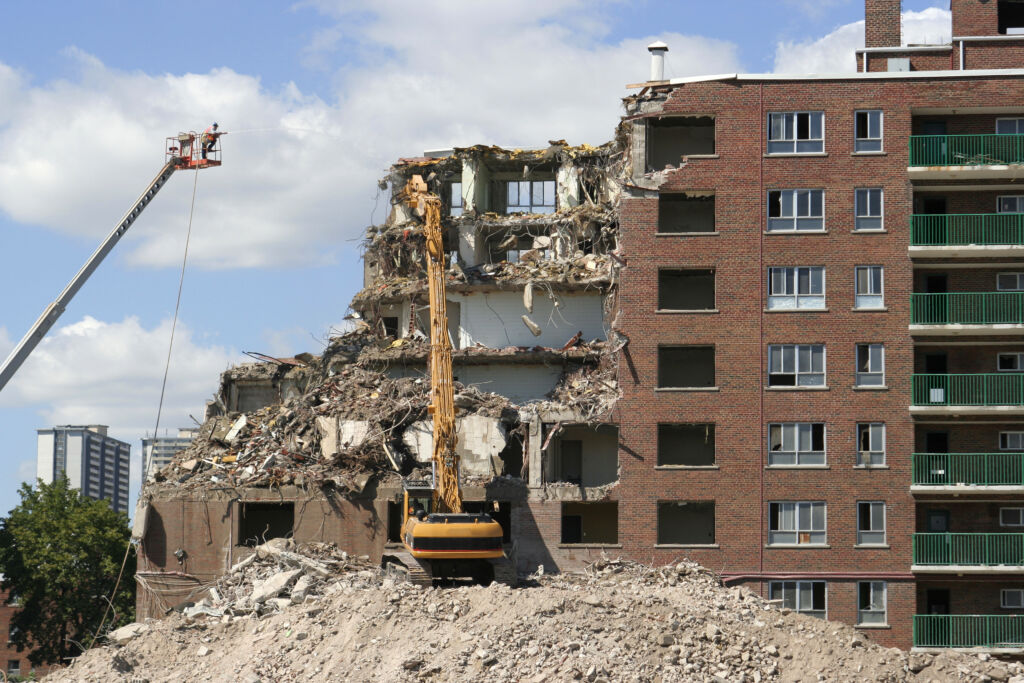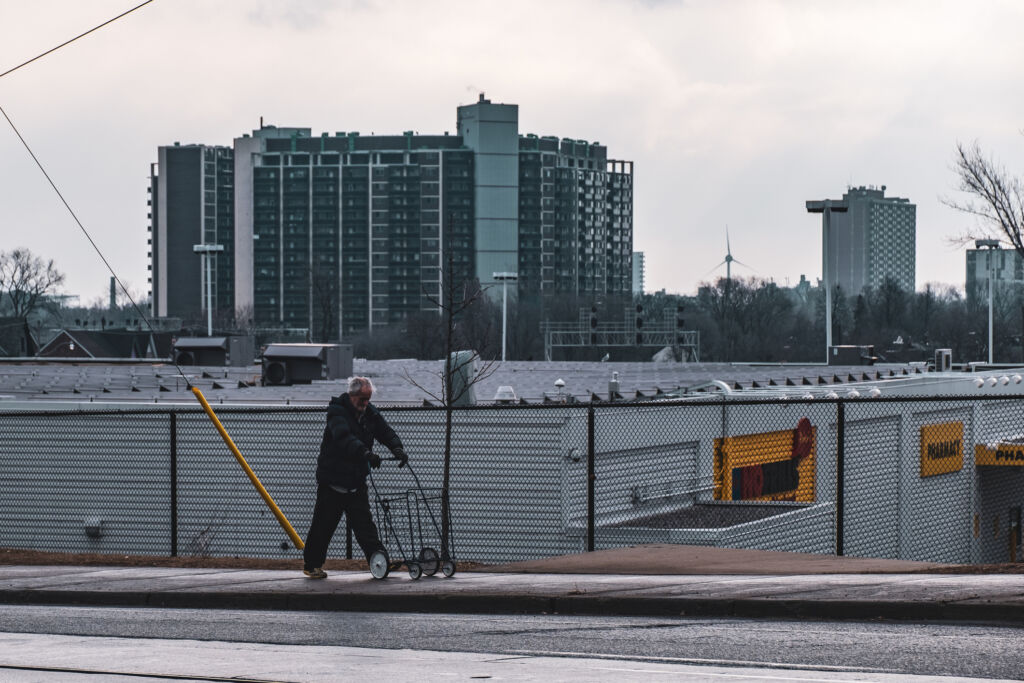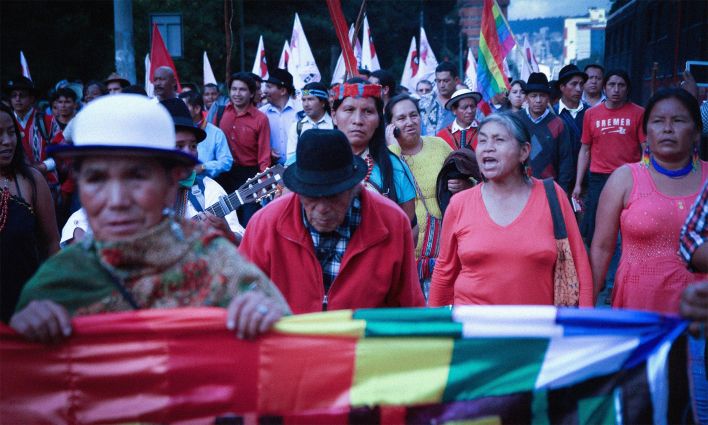Leslie Kern, PhD, is an author who writes about gender and cities, including in her 2019 book, Feminist City: Claiming Space in a Man-Made World and the forthcoming Gentrification is Inevitable and Other Lies. She is also the director of Women’s and Gender Studies at Mount Allison University. Kern sat down with the Monitor and CCPA National Office Senior Researcher, Katherine Scott to talk about her research and building more equitable, accessible cities.
Monitor: One of the reasons I wanted to speak to you for this issue of the Monitor was because your anecdote in Feminist City about trying to navigate the TTC’s many staircases with a stroller has always stuck with me. And I’d like to start our conversation by posing the question from architect and mother Christine Murray that you included in your book: What would cities look like if they were designed by mothers?
Leslie Kern: Thanks for starting with that. In a broad, general sense, those would be cities where care labour is at the top of the priority list. I think whether we’re talking about transportation, clearing snow, home child care policies: all of these things are very low on the agenda of most planners. If you try to look through a city’s official plan for terms like “care”, they’re nowhere. They’re very much an afterthought.
The TTC example illustrates one of the top priorities for a city designed by mothers—or anyone, who’s a primary caregiver, whether that’s to children, to elderly folks, to people with illness or limited mobility. Accessibility is incredibly high on their list, both the physical accessibility of the environment and also the cost accessibility. So transit systems like the TTC, and so many others, inadvertently penalize women and mothers through their fares. Women make less money than men and are more likely to be traveling with other people. They tend to, then, incur a kind of a pink tax on transportation costs.
A city designed by mothers, I think, would also inevitably be a child-friendly city. And it would consider the needs and experiences of children, which again are very kind of low down on most planning agendas. Think about school mobility, for example; just getting kids to and from school and all of the safety issues with traffic and the intense efforts that go into just getting drivers to slow down a little bit in a school zone. I think there’s gotta be a better way to design this, right? So that we’re not just relying on individual drivers behaving well, but instead we create really well-protected and accessible ways for children to move through the city with safe places to play.
Those are some of the first things that come to mind about a city designed by mothers.
Katherine Scott: I’m struck with the current moment and would like to get some of your thoughts on how the pandemic has revealed the gendered dimensions of the city, with an emphasis on the impacts on marginalized women’s lives. How does the idea of a feminist city or a forward-thinking city align with our current moment and the ongoing management of the COVID-19 crisis?
LK: Since the pandemic—the vast majority of the conversations I’ve had about the book have been since the pandemic [began]—those questions have really crystallized, I think because so much of this crisis is really a care crisis at so many levels. Whether we’re talking about the health care system, the education system, or—and perhaps the most salient lead for our conversation here—the care system that relies on the unpaid and underpaid labour of women, of racialized minorities, of recent immigrants, of refugees and asylum seekers working in long-term care homes. [These are] people whose labour is very undervalued and often made invisible.
The pandemic has been a moment where some of that has become more visible. And it has engendered some attempted policy responses, like the final push needed to
move towards a federal child care program. Conversations about what it means if, around the world millions, and locally, thousands of women have been pushed out of the paid workforce.
So how do we create both societies and cities that make it possible for people to work? Because for the economy to function, it requires a robust care infrastructure.
The impetus to go out and enjoy public space has been kind of pointless if there aren’t ... spaces that aren’t overly patrolled or surveilled, that aren’t hardened environments designed to prevent people from actually spending time in them.
KS: It’s certainly a huge focus of what I’ve been doing for the last two years, looking at how this has played out for different marginalized communities. Can you speak a bit more about the role of urban environments during the pandemic? How have they worked with or against marginalized communities that have carried the burden of this pandemic?
LK: Access to public space and green space is one example. We know that there are inequalities in terms of race and income that predate the pandemic. But in the context of a situation where people were increasingly confined to their homes, that [scenario] is maybe not so bad if your home has a backyard and a front yard—just put in a patio—or is a few blocks away from High Park or some other beautiful environment.
But thousands, if not millions, of people around the country live in high-rise environments, deeply urbanized environments and spaces that have been very disinvested in over decades. The impetus to go out and enjoy public space has been kind of pointless if there aren’t safe, accessible kinds of humane spaces that aren’t overly patrolled or surveilled, that aren’t hardened environments designed to prevent people from actually spending time in them.
[These spaces] have no bathrooms, no water fountains, no shelter. It’s all about defending public space from the public, it seems, in many cases. So the pandemic, I think, highlighted some of those inequalities.
I think the home itself is another urban locale where we've had a moment of reckoning in terms of the limitations of the single family home. The fact that we design housing for this traditional nuclear, heterosexual family form with a certain number of children and a domestic division of labour, like we've been doing for decades and decades. But it increasingly does not reflect the nature of families and households. And during the pandemic, I think a lot of people brushed up against it. Frustrations, both in terms of the isolation of all the care labour, and the realization that we don't really have systems of collective sharing of care labour, or even neighbourliness in some cases. We're shut off from that in these little boxes.
There are just not a lot of alternatives currently being built or that are accessible to many people. So I think it's also a moment where things like co-housing and intergenerational or multi-generational housing and cooperative housing are maybe coming back on the table or there's renewed interest in them.
KS: Do you have a list of priorities that you think should drive a progressive recovery to build a safer, more inclusive city of the future?
LK: As someone who studies gentrification, and has written my next book about gentrification, housing is always on my mind. Housing is key. Without a solid basis of adequate, affordable, accessible and good quality housing for everybody, some of the other things that we dream about will not be built upon a [solid] foundation. So I think reinvestment in public housing. And the anti-gentrification and anti-eviction movements that are happening are also really important here.
The state reaching into its dusty old toolbox of regulatory strategies that they’ve resisted for so many decades now and thinking, okay, maybe we don’t have to do it exactly the same as we did in the seventies and eighties, but there might be a place for things like rent control and greater funding of housing alternatives like cooperative housing.
We’ve talked a little bit about transportation, but I think that’s a huge piece of the puzzle in terms of people’s mobility and ability to access work and services. We need to move away from our car-centered reality for a wide range of reasons, which I’m sure are obvious to you and your readers. But from a feminist city perspective, it’s important because women are, in most places, the majority of transit users and are more likely to take pedestrian journeys.
I was just reading about how, in Los Angeles during the pandemic, they made LA Metro free [and allowed rear door boarding]. Now they’re gathering data on this fare-free experiment. Some of the responses from women have been that it was great to just be able to get on the bus at the back without having to struggle with trying to pay the fare at the front of the bus. These are things that are simple, but that make people’s everyday lives way easier.

M: I want to go back to a piece that you wrote in 2016 where you talked about the gentrification of Toronto’s Junction neighbourhood and how the changing landscape there became an access barrier for long-time residents. Can you talk through how gentrification creates those barriers?
LK: When we talk about gentrification, we often focus, and for good reasons, on the physical displacement of people from the communities and this assumption that as wealthier people move in, other people get pushed out. And that’s part of the picture, but there’s this in-between period and the reality that many people stay in a neighbourhood while the neighbourhood fundamentally changes.
And the things that they once had access to—that might be as simple as a diner with an inexpensive cup of coffee, social services, public benches where people might smoke or play a game of chess, or just gather with others—those things start to disappear or get upscaled as different kinds of businesses come in. People often express that they start to feel like strangers in their own neighbourhoods. They’re looked at though they don’t belong, especially if they are a different race than the newcomers coming into that space, or they speak a different language. And so it’s a question of not just the rent rising and people might not be able to afford living there, but that for many people, many of the everyday activities that define what life in a neighbourhood is like begin to shift.
It's like dominoes falling as they start to go. It's very difficult to get them back.
In [Gentrification is Inevitable and Other Lies], I try to go beyond the class-focused story of gentrification—which is of course always important— to take a feminist lens and anti-racist lens, and even an anti-colonial lens to try to explore the ways that gentrification is not just a force that has extra bad effects on women, but that also draws on pre-existing hierarchies, around gender, race, sexuality, ability and age and so on to actually propel itself forward. So gender and equality are not incidental to gentrification, but things that gentrification takes advantage of. A recent U.S. study was talking about how single mothers with children are targeted for evictions by landlords. They’re seen as easy targets, and you can make up all sorts of excuses about disturbances caused by children and so on. And of course, evicting people is often a precursor to raising the rent and an accelerator of the gentrification process.
Similarly, landlords will evict people for calling 911 for domestic violence, because those get recorded sometimes as nuisance calls. And if you are a nuisance tenant, then that's another kind of mark against you. So gentrification definitely makes use of the fact that women are more vulnerable in the housing market to smooth the path forward.
Another example is the privatization of public housing. The majority of public housing tenants are women and women-headed house-holds in most places. So when you privatize public housing, it’s again not just a class-based process, but it’s a process of vast displacement of women.
The fact that so many women, especially low income women, rely on informal networks of care and babysitting and carpooling and walks to school and picking up groceries and checking on mom; when those are disrupted by being dislocated to other places, it’s not just that you’ve moved. It’s like your whole support network crumbles. And what was maybe just manageable before becomes completely untenable.
Gentrification itself is a kind of process of re-inscribing racial hierarchies in urban space.
KS: Could you speak more about those different perspectives? I’d be interested in how gentrification has mobilized or is fuelled by underlying disparity.
LK: Let’s start with the race picture. It has long been recognized that gentrification has different impacts on racialized communities. But again, a lot of the literature has focused on outcomes and impacts without really looking at the fact that historically, even going back a century or longer, practices such as red-lining and residential segregation really set the stage for those great disparities and the great disparity in home ownership rates between those who are white versus those who are not white. And gentrification is a continuation of that racialized capital accumulation process for some over others. Even though, technically speaking, red-lining doesn’t officially happen anymore, and we don’t have official practices of racial segregation, their effects linger to this day.
As gentrification happens, the people who are most likely to be negatively affected are those with the fewest assets and the least wealth. And there still remains a very large wealth gap and asset gap between white folks, especially here in North America, and others.
So gentrification itself is a kind of process of re-inscribing racial hierarchies in urban space.
Thinking about questions like disability, in the book, I talk about the Parkdale neighbourhood in Toronto. When the wave of deinstitutionalization of people with mental illnesses and people who needed other kinds of care was happening [in the 1980s], Parkdale—because of its proximity to [The Centre for Addiction and Mental Health]—became what some people termed a psychiatric ghetto or a service hub, with people living in rooming houses and multi-tenant spaces.
But over time there's been so much disinvestment and depression of value that it has made the neighbourhood ripe for gentrification. But I argue in the book that—like with gender—[this cycle] preys on the vulnerabilities of those who have very little means of fighting back.
So if you are experiencing mental illness, if you're experiencing addiction, if you're precarious, low-income or dependent on state income, you don't have the resources to fight back—at least not individually. It becomes very easy for landlords, and even the city itself, to prey on those communities and displace them because they don't have any clout.
They don't get a lot of sympathy from the rest of the public, either, who might be inclined to see other groups as worthy victims, but not people who are experiencing addiction or engaging in sex work. So that kind of hierarchy in terms of the way that we think about ability, illness, mental illness, and so on, that feeds right into the way that gentrification operates.
KS: I was struck by how with Feminist City you ended on a positive note. You envisioned something different: with the spread of kinship and people organizing. Where do you see hope in the current moment?
LK: I am encouraged by the fact that folks that I’ve had the chance to speak to in professions like planning and architecture and urban design were interested in some of these ideas.
Sometimes I’m frustrated because there’s nothing new in this book. These ideas have been around for a long time, but [people say], oh, if only I’d had this to read in my architecture degree, if only I had read this in my planning degree. I’m heartened to hear that because I think it does indicate interest. But it’s also frustrating because people have been writing about this for many, many decades. So it’s very slow, incremental change in those professional spaces.
I guess the hopeful signs might be the re-recognition that public space is valuable. Not to over-valorize a middle-class awakening, but now we observe life in urban public space, [realizing] there’s nowhere to sit and everything is hostile and hard and it’s very unpleasant. Many people have known these things for a long time: that in the name of security, some notion of safety and aesthetic principles, we’ve made it impossible for people to enjoy being in public.
In some cases, I’ve taken that to heart; in Montreal, for example, which maybe has been better at public space. When I went to visit my daughter this past summer, there were so many streets—major streets—totally closed to cars, and they had all of these tables and benches and movable furniture, which you just never see in urban space. And there were little parkettes taking up space on the road. All of these sites have actually remained in place over this period of the pandemic. There’s hope that they will continue to remain in place.
So I think that is kind of hopeful, right? If we can take more space away from cars, if we can reinvigorate the public sphere in ways that make it hospitable for a wide variety of people, I think that’s a really important shift.
There was maybe more hope earlier on when we saw eviction moratoriums and rent controls and things like that. I guess if there's a kernel of hopefulness there, it's around governments being reminded that they do actually have some power over the housing market. They're very reluctant to use it. But instead of saying, there's nothing we can do about housing, they did actually do some things, even if [the actions] were more short-lived than they needed to be. And maybe it's a reminder for the public, too.
Another thing might be the universal basic income, which essentially, in Canada, the CERB functioned as for a period of time, or close to it. I know in the UK, they were talking a lot about UBI and I've heard more public discourse about it here than I had in a while. And I think it's a very feminist policy solution because it actually recognizes the value of care, because you're being paid for care labour, implicitly. If you're at home and you're not working in the public workforce, you're still receiving an income and there's a recognition that you are contributing to society by feeding people, doing laundry, whatever it is you might be doing at home. So I think some of those new shifts, at least in discourse and public consciousness, are glimmers of hope.
Leslie Kern’s new book, Gentrification is Inevitable and Other Lies, will be released on September 6, 2022.






